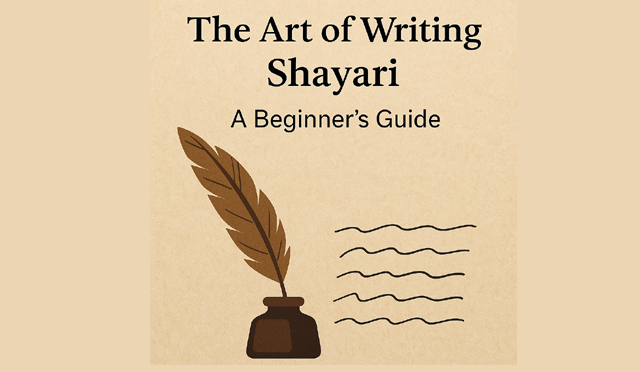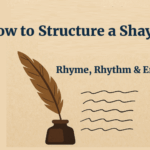What Makes Shayari So Magical?
If you’ve ever come across a two-line verse that spoke straight to your heart, made you smile, or brought a tear to your eye, chances are, you’ve experienced the magic of Shayari.
Unlike long poems or novels, Shayari expresses deep emotions in just a few words. It’s personal. It’s powerful. And the best part? Anyone can learn the art of writing Shayari, even if you’re just starting out.
In this beginner’s guide, you’ll learn not just how to write Shayari, but why it matters, how it differs from regular poetry, and how to express your own emotions through it, authentically and beautifully.
What is Shayari? A Quick Overview
Shayari is a form of poetry popular in Urdu and Hindi literature. It usually involves rhymed couplets and covers topics like love, pain, heartbreak, attitude shayari, beauty, longing, and philosophy.
Key Characteristics of Shayari:
-
Written in two to four lines (often called a sher or couplet)
-
Rhythmic and musical
-
Emotionally charged and relatable
-
Uses metaphors, imagery, and wordplay
Shayari is not just writing, it’s feeling that flows through words.
Shayari vs Traditional Poetry
| Feature | Shayari | Traditional Poetry |
|---|---|---|
| Origin | Urdu, Hindi, Persian traditions | Global (English, Japanese, French, etc.) |
| Structure | Mostly two-line couplets | Varies: sonnets, haikus, free verse |
| Language | Urdu, Hindi, often Roman script | Any |
| Emotion | Intimate, romantic, soulful | Varies widely by form and theme |
| Complexity | Simple but deep | Ranges from simple to highly complex |
| Audience | Mass appeal (Instagram, YouTube) | Literary, academic, or niche groups |
The Foundation – How to Start Writing Shayari
Step 1: Choose a Theme That Matters to You
Shayari becomes powerful when it’s written from the heart. Ask yourself:
-
Are you in love?
-
Have you experienced heartbreak?
-
Do you want to express hope, loss, or beauty?
Beginner Tip: Start with what you feel most strongly. If you’re sad, write about pain. If you’re happy, write about joy.
Step 2: Keep It Short and Sweet
Most Shayari is written in two lines. It doesn’t have to be long to be meaningful.
Example (Original Shayari):
“Tere bina zindagi mein kya raha,
Jaise baadalon ke bina barsaat adhura sa tha.”
Meaning: Life feels incomplete without someone special—like rain without clouds.
Understand the Structure – Rhyming and Flow
Radeef and Qaafiya – Basics of Rhyming in Shayari
Traditional Urdu Shayari uses:
-
Qaafiya: The rhyming word (before the ending)
-
Radeef: The repeating phrase at the end of both lines
Example:
“Har ek baat pe kehte ho tum ki tu kya hai,
Tumhi kaho ke yeh andaaz-e-guftagu kya hai?”
— Mirza Ghalib
The words “kya hai” are the Radeef, while “guftagu” and “tu” are part of the Qaafiya.
Beginner Tip: You don’t have to start with these rules. But learning them helps you write better Shayari over time.
Language and Style – Keep It Relatable
Shayari is for feeling, not impressing.
Use simple words that are easy to understand but full of depth.
Original Shayari Example 1 – Heartbreak
“Uski muskurahat mein bhi kuch toh tha,
Shayad isiliye hum rota rahe.”
Meaning: Even their smile held something that made me cry, maybe because it wasn’t mine anymore.
Original Shayari Example 2 – Hope
“Tanha raaton se darna chhod diya,
Khud se mulaqat ka silsila shuru ho gaya.”
Meaning: I stopped fearing lonely nights. They became moments of self-discovery.
Find Inspiration : From the Masters and the Moments
Great Shayars like Mirza Ghalib, Faiz Ahmed Faiz, Javed Akhtar, and Rahat Indori turned everyday emotions into timeless verses.
But don’t just copy them, observe your own life.
-
A breakup? Write it.
-
A night under stars? Describe it.
-
A forgotten friendship? Feel it.
Real life is the best teacher of Shayari.
Tools and Tips for Beginners
1. Read a Lot of Shayari Daily
-
Follow Shayari pages on Instagram or Pinterest
-
Read books by popular Shayars
-
Watch Shayari recitals on YouTube
2. Start with Free Verse Shayari
Don’t worry about rhymes in the beginning. Just focus on expressing your thoughts.
3. Write Daily – Even One Shayari a Day Helps
Consistency matters. Even if your first 50 Shayari lines don’t feel good, the 51st might just touch hearts.
4. Use a Shayari Journal or Note App
Whenever inspiration hits, during a bus ride, a walk, or a sad song—write it down. Emotions don’t follow schedules.
Frequently Asked Questions (FAQs)
Q1: Do I need to know Urdu to write Shayari?
No. While traditional Shayari is in Urdu, many modern Shayars write in Hindi, Roman Urdu, and even English-Hindi mixed formats. Just keep the emotion intact.
Q2: Can Shayari be funny?
Absolutely! Shayari can express humor, sarcasm, or satire, just like any other emotion.
Q3: How long should a beginner’s Shayari be?
Start with 2 lines (couplet or sher). Gradually, you can write longer verses or nazms.
Conclusion: The Soulful Joy of Writing Shayari
The art of writing Shayari is more than just arranging words, it’s about listening to your heart and giving it a voice.
Whether you’re writing about love, loneliness, joy, or sorrow, if it’s honest, it’s beautiful.



